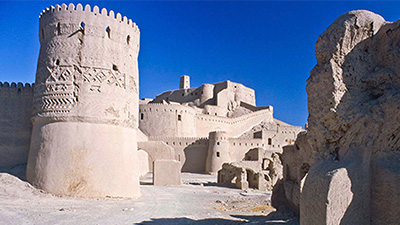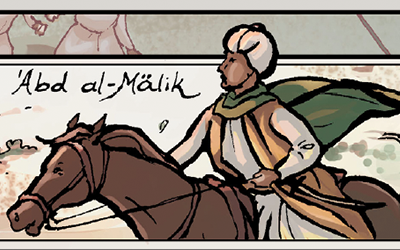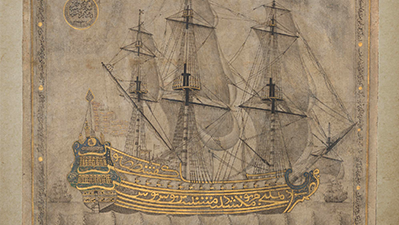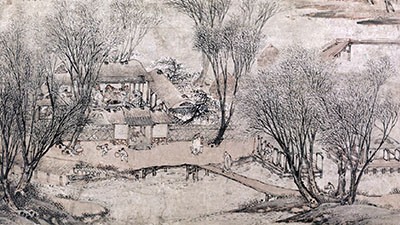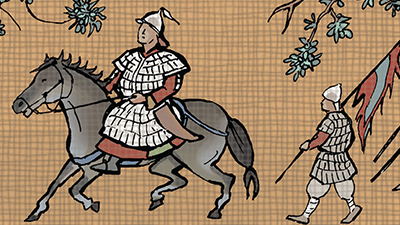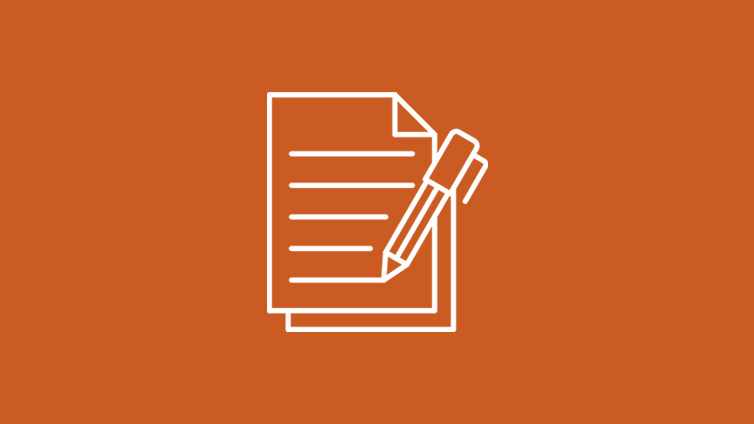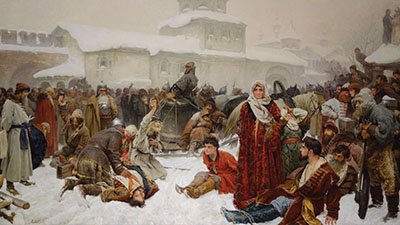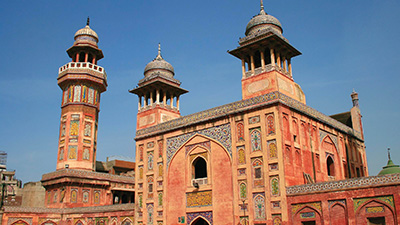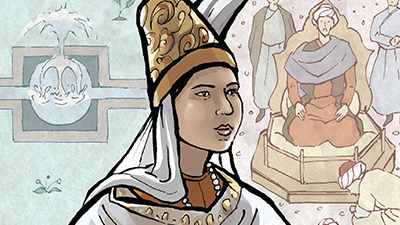Land-Based Empires
Teacher Resources
Driving Question: How did land-based empires maintain control over such vast regions?
Large land-based empires controlled vast regions of Afro-Eurasia between 1450 and 1750. The empires covered in this lesson used a variety of strategies to rule over diverse peoples. How did they ensure that their subjects obeyed the empire’s rules?
Learning Objectives:
- Examine how early modern empires were structured and how they interacted with others through networks of exchange.
- Use a graphic biography to support, extend, or challenge the overarching narratives from this period.
- Use claim testing to evaluate the use of evidence.
Vocab Terms:
- administrative
- aristocracy
- bureaucracy
- centralized
- enslave
- hajj
- Janissary
Opener: Land-Based Empires
To teach this lesson step, refer to page 3 of the Lesson 3.2 Teaching Guide.
Taxes, religious freedom, military recruitment, infrastructure—these are all problems you’ll need to solve as a new emperor.
Gunpowder Empires
To teach this lesson step, refer to page 3 of the Lesson 3.2 Teaching Guide.
Want to dig deeper into gunpowder empires? Check out this OER Project topic page.
Gunpowder empires were about more than just the guns for which they were named; they also had powerful management skills.
-
Guiding Questions
-
Before you read
Preview the questions below, and then skim the article. Be sure to look at the section headings and any images.
While you read
Look for answers to these questions:
- Which empires are referred to as gunpowder empires and why are they called this?
- How did gunpowder help emperors rule their territories?
- How were the Mongols important to these new empires?
- How did these empires use religion to govern?
- How did gunpowder technology change political dynamics in Europe?
After you read
Respond to this question: Do you think gunpowder empires is a good name for these empires? Why or why not? Can you think of a better name?
-
Guiding Questions
-
Before you read
Preview the questions below, and then skim the comic, paying attention to things like prominent colors, shapes, and types of text and fonts. How do you know where to start and in which direction to read? What’s in the gutters (the space between panels)? Who or what is the focus of the comic?
While you read
- Which countries were the main threats to Morocco during the period of Sa’âdi rule, and what were the religions of their leaders?
- Who was Mawläy ‘Abd al-Mälik’s main rival for the Moroccan throne, and to whom did this competitor turn for support?
- In your own words, what was in Mawläy ‘Abd al-Mälik’s letter to Don Sebastián I?
- What was the outcome of the Battle of the Three Kings?
- Why do you think the artist drew the Atlantic Ocean and the Mediterranean Sea crisscrossed by lines in the top panel?
After you read
Respond to this question: How does this biography of Mawläy ‘Abd al-Mälik support, extend, or challenge what you have learned about international relations and conflict in this period?
Ottoman Empire
To teach this lesson step, refer to page 5 of the Lesson 3.2 Teaching Guide.
Need a good poster for your classroom? Check out these Claim Testing posters.
The Ottoman Empire spanned three continents. Ruling such a large and diverse territory called for unique strategies. Use the activity and article below to identify major claims about Ottoman rule.
-
Guiding Questions
-
Before you read
Preview the questions below, and then skim the article. Be sure to look at the section headings and any images.
While you read
Look for answers to these questions:
- Why is the story of Master Orban problematic?
- What factors are listed in this article as contributing to Ottoman success?
- Why was the lack of a permanent aristocracy an advantage?
- What was the devshirme?
- What other title did the sultans claim? Why was this important?
After you read
Respond to this question: What similarities and differences do you see between the Ottoman Empire and other empires you have encountered in this course?
Qing Dynasty China
To teach this lesson step, refer to page 7 of the Lesson 3.2 Teaching Guide.
OER Project teachers love empire building! Check out this community conversation to see what they’ve done with this activity.
The Ming and Qing dynasties ruled China from 1368 to 1912. China was the wealthiest empire in the world, then it wasn’t, then it was again. These resources will help you chart these rise and falls.
-
Guiding Questions
-
Before you read
Preview the questions below, and then skim the article. Be sure to look at the section headings and any images.
While you read
Look for answers to these questions:
- What were the two dynasties that ruled China from 1450 to 1750, and what were their periods of rule?
- What was the “turn inland” after 1433, and why did it happen?
- What was the focus of the Yongle Emperor (1402–1424)?
- What caused the fall of the Ming dynasty and the rise of the Qing dynasty around 1640?
- What policies did the Kangxi Emperor (1661–1772) pursue?
After you read
Respond to this question: Do you think the trade policies adopted by the Qing dynasty were a mistake? Why or why not?
-
Guiding Questions
-
Before you read
Preview the questions below, and then skim the comic, paying attention to things like prominent colors, shapes, and types of text and fonts. How do you know where to start and in which direction to read? What’s in the gutters (the space between panels)? Who or what is the focus of the comic?
While you read
- How did Zheng He come to have three names?
- What did Zheng He do as the admiral of the Ming dynasty?
- How does Xu Zu-Yuan describe these journeys, and how does this contrast to later Portuguese expeditions in this region?
- How does Geoff Wade describe these journeys, and what is his evidence?
- How does the artist use art and design to contrast and illustrate the two big theories about Zheng He’s voyages?
After you read
Respond to this question: How does this biography of Zheng He support, extend, or challenge what you have learned about connections across Afro-Eurasia in this period?
Closer: Land-Based Empires
To teach this lesson step, refer to page 12 of the Lesson 3.2 Teaching Guide.
Early modern empires were massive bureaucracies ruling over millions of people. This activity lets you step into the shoes of one person—the emperor.
Reviewing for Analysis and Evidence
To teach this lesson step, refer to page 12 of the Lesson 3.2 Teaching Guide.
Providing solid evidence and analyzing it is crucial for building a strong written argument. Look for these elements in a sample student essay.
The Russian Empire
To teach this lesson step, refer to page 13 of the Lesson 3.2 Teaching Guide.
Meet the Muscovy. From their defeat of the Mongols to the Romanov era Russian Empire, the world of the Muscovy is a fascinating one. In this article, you’ll get to know them socially, culturally, and politically.
-
Guiding Questions
-
Before you read
Preview the questions below, and then skim the article. Be sure to look at the section headings and any images.
While you read
Look for answers to these questions:
- Why have historians generally paid more attention to southern Eurasia than northern Eurasia?
- Who drove the Mongol “Golden Horde” out of Muscovy, the region around today’s Moscow?
- How long did the Romanovs rule the Russian Empire?
- Who were the serfs and who were the boyars in imperial Russia? What were their roles?
- How and where did the Russian Empire expand under the Romanovs?
After you read
Respond to this question: How did the role of the Orthodox Church in Muscovy/Russia compare with the role of religions in other Eurasian land-based empires?
The Mughals
To teach this lesson step, refer to page 14 of the Lesson 3.2 Teaching Guide.
The Mughal Empire produced many goods for trade, but spent a lot of their time trying to keep their people working together. This article and graphic biography will help you understand how they did it.
-
Guiding Questions
-
Before you read
Preview the questions below, and then skim the article. Be sure to look at the section headings and any images.
While you read
Look for answers to these questions:
- What groups or classes of people were the most important supporters of Mughal rule?
- Like other empires, the Mughal Empire had lots of different communities. How did it successfully rule all these groups until the mid-eighteenth century?
- What was the role of the Mughal Empire in the global economy?
- What internal challenges did the Mughal emperors face in 1750?
- What external challenges did the Mughal emperors face in 1750?
After you read
Respond to this question: What aspects of the Mughal Empire in 1750 seem unique or distinctive, and what aspects seem to be part of a wider global pattern?
-
Guiding Questions
-
Before you read
Preview the questions below, and then skim the comic, paying attention to things like prominent colors, shapes, and types of text and fonts. How do you know where to start and in which direction to read? What’s in the gutters (the space between panels)? Who or what is the focus of the comic?
While you read
- How was Khanzada Begum related to the first Mughal emperors, Babur and Humayun?
- Why did Khanzada Begum marry Muhammad Shaybani Khan, and why were they divorced?
- How did Khanzada Begum help her brother in his conflict with the Uzbeks after her divorce?
- How did Khanzada Begum help her nephew rule?
- How does the artist use art and design to demonstrate the power and authority of Khanzada Begum?
After you read
Respond to this question: How does this biography of Khanzada Begum support, extend, or challenge what you have learned about the gunpowder empires, and government generally, in this era?



